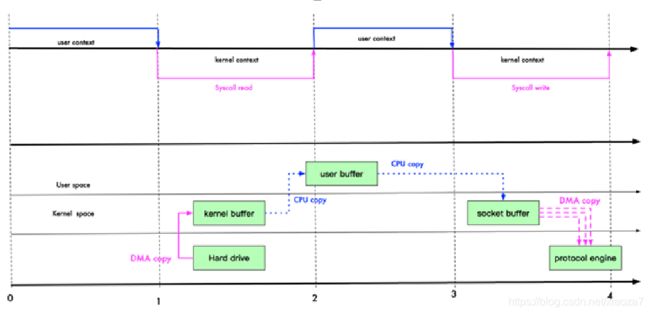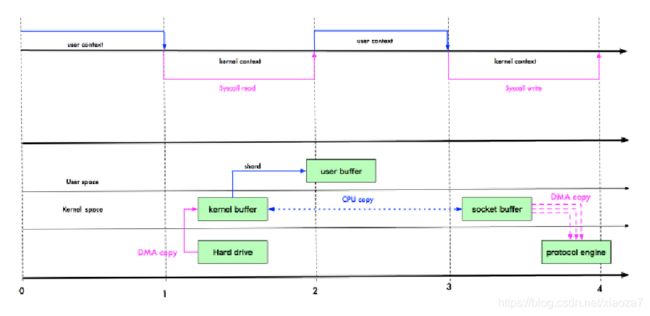NIO的零拷贝
java中零拷贝有2种(零拷贝是指没有CPU拷贝)
1,mmap(内存映射)
2,sendfile
传统IO数据读写;
File file = new File("test.txt");
RandomAccessFile raf = new RandomAccessFile(file, "rw");
byte[] arr = new byte[(int) file.length()]; raf.read(arr);
Socket socket = new ServerSocket(8080).accept();
socket.getOutputStream().write(arr);
过程如下;
传统IO发现copy了4次,cpu状态切换三次,
所以要优化;
MMAP优化:
mmap 通过内存映射,将文件映射到内核缓冲区,同时,用户空间可以共享内核空间的数据。这样,在进行网络传输时,就可以减少内核空间到用户控件的拷贝次数。如下图
此时copy 3次,状态也是3次,
sendFile 优化
Linux 2.1 版本 提供了 sendFile 函数,其基本原理如下:数据根本不经过用户态,直接从内核缓冲区进入到 Socket Buffer,同时,由于和用户态完全无关,就减少了一次上下文切换 示意图和小结 提示:零拷贝从操作系统角度,是没有cpu 拷贝
此时是3次拷贝,切换变成了2次;
Linux 在 2.4 版本中,做了一些修改,避免了从内核缓冲区拷贝到 Socket buffer 的操作,直接拷贝到协议栈,从而再一次减少了数据拷贝。具体如下图和小结: 这里其实有 一次cpu 拷贝 kernel buffer -> socket buffer 但是,拷贝的信息很少,比如 lenght , offset , 消耗低,可以忽略
上图中socketbuffer变成灰色,kernel buffer可以通过DMA copy进入 protocol engine;
我们说零拷贝,是从操作系统的角度来说的。因为内核缓冲区之间,没有数据是重复的(只有 kernel buffer 有一份数据)。 零拷贝不仅仅带来更少的数据复制,还能带来其他的性能优势,例如更少的上下文切换,更少的 CPU 缓存伪共享以及无 CPU 校验和计
mmap 和 sendFile 的区别 mmap 适合小数据量读写,sendFile 适合大文件传输。 mmap 需要 4 次上下文切换,3 次数据拷贝;sendFile 需要 3 次上下文切换,最少 2 次数据拷贝。 sendFile 可以利用 DMA 方式,减少 CPU 拷贝,mmap 则不能(必须从内核拷贝到 Socket 缓冲区)。
例子:
比如下面的零拷贝
public class NewIOClient {
public static void main(String[] args) throws Exception {
SocketChannel socketChannel = SocketChannel.open();
socketChannel.connect(new InetSocketAddress("localhost", 6666));
String filename = "pro*****.zip";
//得到一个文件channel
FileChannel fileChannel = new FileInputStream(filename).getChannel();
//准备发送
long startTime = System.currentTimeMillis();
//在linux下一个transferTo 方法就可以完成传输
//在windows 下 一次调用 transferTo 只能发送8m , 就需要分段传输文件, 而且要主要
//传输时的位置 =》
//transferTo 底层使用到零拷贝
long transferCount = fileChannel.transferTo(0, fileChannel.size(), socketChannel);
System.out.println("发送的总的字节数 =" + transferCount + " 耗时:" + (System.currentTimeMillis() - startTime));
//关闭
fileChannel.close();
}
}
//服务器
public class NewIOServer {
public static void main(String[] args) throws Exception {
InetSocketAddress address = new InetSocketAddress(6666);
ServerSocketChannel serverSocketChannel = ServerSocketChannel.open();
ServerSocket serverSocket = serverSocketChannel.socket();
serverSocket.bind(address);
//创建buffer
ByteBuffer byteBuffer = ByteBuffer.allocate(4096);
while (true) {
SocketChannel socketChannel = serverSocketChannel.accept();
int readcount = 0;
while (-1 != readcount) {
try {
readcount = socketChannel.read(byteBuffer);
}catch (Exception ex) {
// ex.printStackTrace();
break;
}
//
byteBuffer.rewind(); //倒带 position = 0 mark 作废
}
}
}
}
以及老的拷贝方式:
public class OldIOClient {
public static void main(String[] args) throws Exception {
Socket socket = new Socket("localhost", 6666);
String fileName = "proto***.zip";
InputStream inputStream = new FileInputStream(fileName);
DataOutputStream dataOutputStream = new DataOutputStream(socket.getOutputStream());
byte[] buffer = new byte[4096];
long readCount;
long total = 0;
long startTime = System.currentTimeMillis();
while ((readCount = inputStream.read(buffer)) >= 0) {
total += readCount;
dataOutputStream.write(buffer);
}
System.out.println("发送总字节数: " + total + ", 耗时: " + (System.currentTimeMillis() - startTime));
dataOutputStream.close();
socket.close();
inputStream.close();
}
}
//java IO 的服务器
public class OldIOServer {
public static void main(String[] args) throws Exception {
ServerSocket serverSocket = new ServerSocket(6666);
while (true) {
Socket socket = serverSocket.accept();
DataInputStream dataInputStream = new DataInputStream(socket.getInputStream());
try {
byte[] byteArray = new byte[4096];
while (true) {
int readCount = dataInputStream.read(byteArray, 0, byteArray.length);
if (-1 == readCount) {
break;
}
}
} catch (Exception ex) {
ex.printStackTrace();
}
}
}
}
old用时:
文件越大,差异体现的更明显





